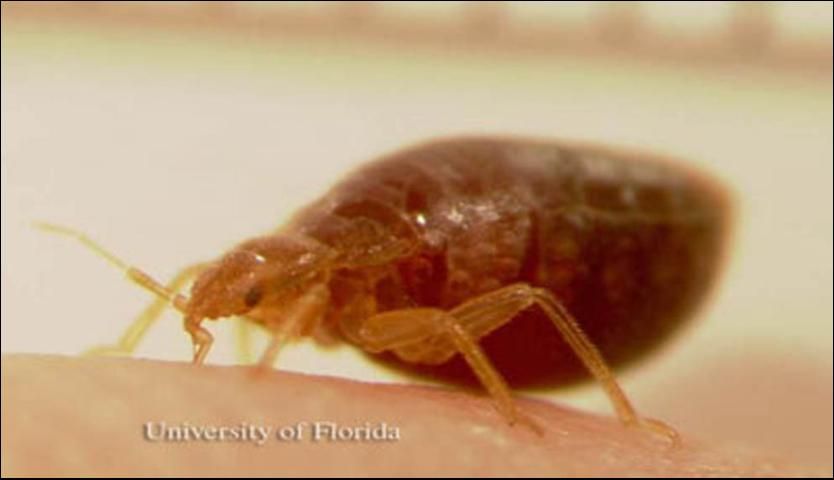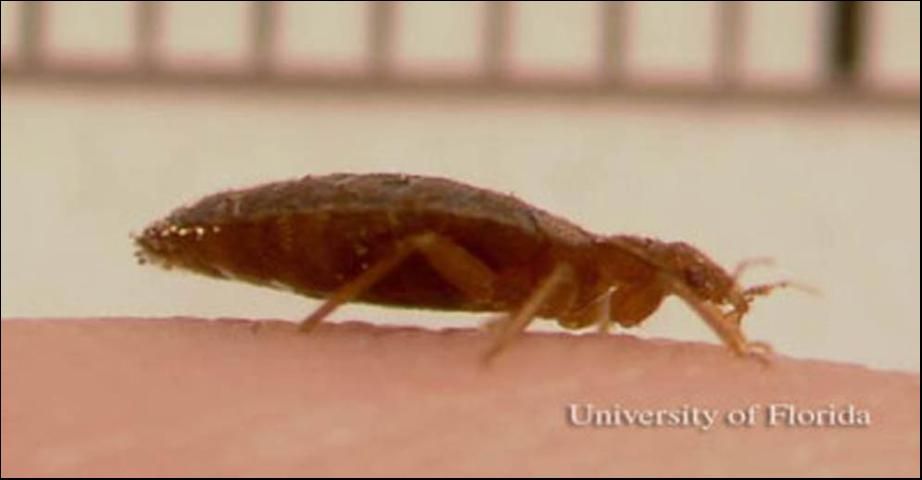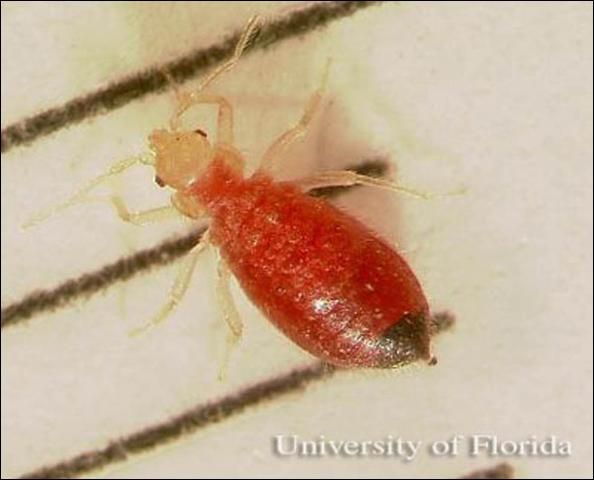Introduction
Sometimes referred to as red coats, chinches, or mahogany flats (USDA 1976), bed bugs, Cimex lectularius Linnaeus, are blood-feeding parasites of humans, chickens, bats, and occasionally domesticated animals (Usinger 1966). Bed bugs are suspected to carry leprosy, oriental sore, Q-fever, and brucellosis (Krueger 2000) but have never been implicated in the spread of disease to humans (Dolling 1991). After the development and use of modern insecticides, such as DDT, bed bug infestations have virtually disappeared. However, since 1995, pest management professionals have noticed an increase in bed-bug-related complaints (Krueger 2000).

Credit: Joseph Smith, University of Florida
Distribution
Human dwellings, bird nests, and bat caves are the most suitable habitats for bed bugs because they offer warmth, areas to hide, and hosts on which to feed (Dolling 1991). Bed bugs are not evenly distributed throughout the environment but are concentrated in harborages (Usinger 1966). Within human dwellings, harborages include cracks and crevices in walls and furniture, behind wallpaper and wood paneling, or under carpeting (Krueger 2000). Bed bugs are usually only active during the night but will feed during the day when hungry (Usinger 1966). Bed bugs can be transported on clothing and in luggage, bedding, and furniture (USDA 1976). Bed bugs lack appendages that allow them to cling to hair, fur, or feathers, so they are rarely found on hosts (Dolling 1991).
Description
The adult bed bug is a broadly flattened, ovoid insect with greatly reduced wings (Schuh and Slater 1995). The leathery, reduced fore wings (hemelytra) are broader than they are long, with a somewhat rectangular appearance. The sides of the pronotum are covered with short, stiff hairs (Furman and Catts 1970). Before feeding, bed bugs are usually brown in color and range from 6 to 9.5 mm (1/4 to 3/8 in) in length. After feeding, the body is swollen and red in color (USDA 1976).

Credit: David Almquist, University of Florida

Credit: Joseph Smith, University of Florida

Credit: Joseph Smith, University of Florida
The two bed bugs most important to people are the common bed bug, Cimex lectularius, and the tropical bed bug, Cimex hemipterus. These two species of bed bugs can be easily distinguished by looking at the prothorax, the first segment of the thorax. The prothorax of the common bed bug is more expanded laterally and the extreme margins are more flattened than that of the tropical bed bug (Ghauri 1973).
Life Cycle
Because of their confined living spaces, copulation among male and female bed bugs is difficult. The female possesses a secondary copulatory aperture, Ribaga's organ or paragenital sinus, on the fourth abdominal sternum where spermatozoa from the male are injected. The spermatozoa then migrate to the ovaries by passing through the haemocoel, or body cavity (Dolling 1991). The female bed bug lays approximately 200 eggs during her life span at a rate of one to 12 eggs per day (Krueger 2000). The eggs are laid on rough surfaces and coated with a transparent cement to adhere them to the substrate (Usinger 1966). Within six to 17 days bed bug nymphs, almost devoid of color, emerge from the eggs. After five molts, which take approximately ten weeks, the nymphs reach maturity (USDA 1976).
Survey and Management
Bed bugs are most active at night, so their infestations are not easily located (Snetsinger 1997). However, when bed bugs are numerous, a foul odor from oily secretions can easily be detected (USDA 1976). Other recognizable signs of a bed bug infestation include excrement left around their hiding places (Dolling 1991) and reddish brown spots on mattresses and furniture (Frishman 2000). Good sanitation is the first step to controlling the spread of bed bugs. However, upscale hotels and private homes have recently noted infestations, suggesting that good sanitation is not enough to stop a bed bug infestation (Krueger 2000).
If bed bugs are located in bedding material or mattresses, control should focus on mechanical methods, such as vacuuming, caulking, and removing or sealing loose wallpaper, to minimize the use of pesticides (Frishman 2000). The effectiveness of using steam cleaners or hot water to clean mattresses is questionable. Heat is readily absorbed by the mattress and does no harm to the bed bug. For severe infestations, however, pesticides may be used. Care should be taken not to soak mattresses and upholstery with pesticides. Allow bedding and furniture to dry thoroughly before using. One study shows that over-the-counter foggers are not effective for controlling bed bugs (Jones and Bryant 2012).
For more information, see Bed Bugs and Blood-Sucking Conenose (https://edis.ifas.ufl.edu/IG083).
Selected References
Dolling WR. 1991. The Hemiptera. Oxford University Press, New York, New York.
[EPA] U.S. Environmental Protection Agency. 2018. Bed bugs: get them out and keep them out. https://www.epa.gov/bedbugs. (12 March 2021)
Fasulo TR. (2002). Bloodsucking Insects. UF/IFAS SW 156.
Frishman A. 2000. Bed bug basics and control measures. Pest Control 68: 24.
Furman DP, Catts E. 1970. Manual of Medical Entomology, 3rd ed. National Press Books, Palo Alto, California.
Ghauri MSK. 1973. Hemiptera (bugs), pp. 373–393. In Smith K.G.V. [ed], Insects and Other Arthropods of Medical Importance. British Museum, London, England.
Jones SC, Bryant JL. 2012. Ineffectiveness of over-the-counter total-release foggers against the bed bug (Heteroptera: Cimicidae). Journal of Economic Entomology 105: 936–942.
Koehler PG, Pereira RM, Pfiester M, Hertz J. (July 2011). Bed bugs and blood-sucking conenose. EDIS. https://edis.ifas.ufl.edu/ig083 (26 April 2017).
Krueger L. 2000. Don't get bitten by the resurgence of bed bugs. Pest Control 68: 58–64.
Snetsinger R. 1997. Bed bugs & other bugs, pp. 393–425. In Mallis A, Hedges SA [eds.], Handbook of Pest Control, 8th ed. Franzak & Foster Co., Cleveland, Ohio.
Schuh R, Slater JA. 1995. True Bugs of the World (Hemiptera : Heteroptera) Classification and Natural History. Cornell University Press, Ithaca, New York.
[USDA] U.S. Department of Agriculture. 1976. How to Control Bed Bugs. USDA. Washington D.C.
Usinger RL. 1966. Monograph of Cimicidae (Hemiptera-Heteroptera). Entomological Society of America, College Park, Maryland.